Hello!
Having been inspired by working in the glasshouses of the University of Oxford´s Botanic Garden I decided that I wanted to visit South America.
I've been in South America now for almost 5 weeks and as the time has flown by I have come across a range of climates, habitats and hole range of exciting plants, and also exciting uses for plants. So much so that I felt that I had to dedicate an entire blog to them.
I am certainly not an expert on plants inparticularly ones from South America, I have tried my best to identify species, or make a guess. Please feel free to correct me by posting a comment. I am trying to pick up as much knowledge from asking local people (usually the best source), visiting local museums and from various websites. I hope to include various ethnobotanic uses too.
I am travelling with my boyfriend who has patiently humoured me when I`ve wanted to stop a bus to get out to get a photo of a plant. You can read about our general trip at www.petestravels.blogspot.com.
The Pampas
We took a 3 day tour of the Pampas from Rurrenabaque, Bolivia. Rurrenbaque is a small town on the edge of the tropical forests of bolivia, about a 16 hour very uncomfortable bus ride to the east of La Paz and the Bolivian Altiplano. It has a tropical climate with high humidity with an wide range of rainfall averages ranging from 700mm in the driest parts to 5000mm in the most humid places the temperature ranges from 20 - 35 degrees celcius.
Rurrennabaque is the main jumping off point for tours of the Pampas, more open areas of jungle characterised with areas or grass, Pampas tours are more popular with tourists than jungle as there is more open space to see cute fluffy monkeys and other animals (the tour agencies never mention how exciting the plants are!) Due to time constraints and having to be in Peru for the 9th of August we had to do a short 3 day tour of the Pampas (to get the jungle takes at least a day to travel there and a day to travel back, so the Jungle will have to wait till later!)
We had a very dusty drive for three hours from Rurrenbaque, the flora dominating the landscape was palms, grassland and quite a lot of marshy areas. The drive was punctuated with stops for sightings of wildlife - Crocodiles and a sloth and a quick change of tyre when we got a punture on the rough terrain. Arriving on the banks of the Tuichi River, we were honored with a display from the local Pink river dolphin team. We met our guide, Wilson and loaded our bags into a Canoe and then spent 3 hours motoring up river taking in the wildlife as we went. It really struck me as we journyed up how many amazing different species of plants there were - I could only recognise a few, there was a couple of Ficus sp. not the small straggly things you see growing on supermarket shelves but huge trees, plunging new trunks into the ground. I also recongnised a couple of aquatic plants, the water lettuce Pistia stratiotes and the water hyacinth, Eichhornia crassipes, which certainly seemed quite invasive.
The next day, we went for a walk across the Pampas in search of Anacondas, this was an area of very wet grass land, the area floods during the rainy season. Again the only plant I could recognise was the sensitive plant, Mimosa pudica everyone took great delight in stroking the leaves and watching them suddenly wither in front of their eyes.
The third day we spent on the river, trying to catch Pirhanas for our supper and swimming, aparently if the Pink dolphins are near by there are no Crocodiles, Caymen or Pirhanas about well thats what our guide assured us as we all dived in!
Salar de Uyuni and the Altiplano
The next area of exciting plants was in the Bolivian Altiplano. We took a 4 day tour of the famous Salar de Uyuni and surrounding lakes and vocanoes.

The vast expanse of the Salar
The Salar is 3665m above sea level and covers an area of 12,000 sq.m the salt ranges in thickness from 2-20m and is a left over from a giant inland sea. The amount of salt in the Salar is considered to be 64 000 million tonnes. Not only is it a large reserve of salt but also is rich in Lithium, Magnesium and Borax. During on the first day of the tour we drove across the Salar to Isla Pescado, or Fish Island, so called because of its shape. It is an isolated oasis in the middle of a salt dessert with its own unique ecosystem, including huge Oreocereus sp. Cacti, one specimen being 12m tall.
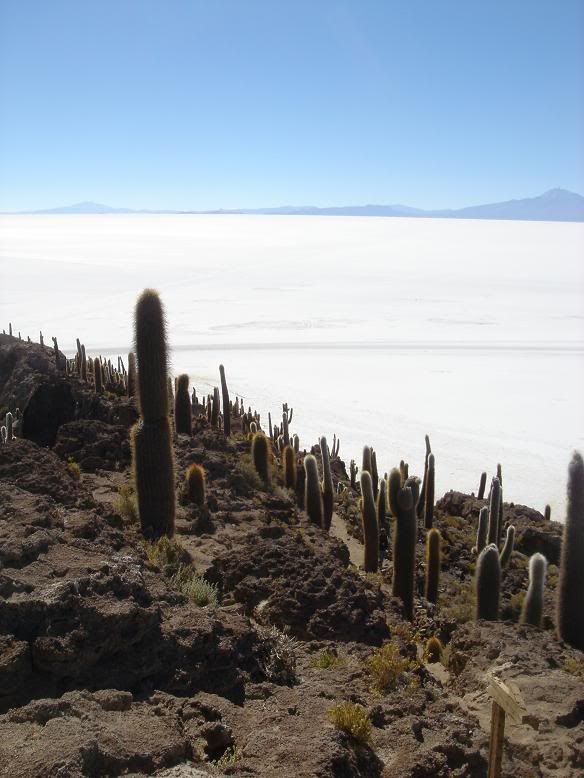
Huge cacti on Isla Pescado.
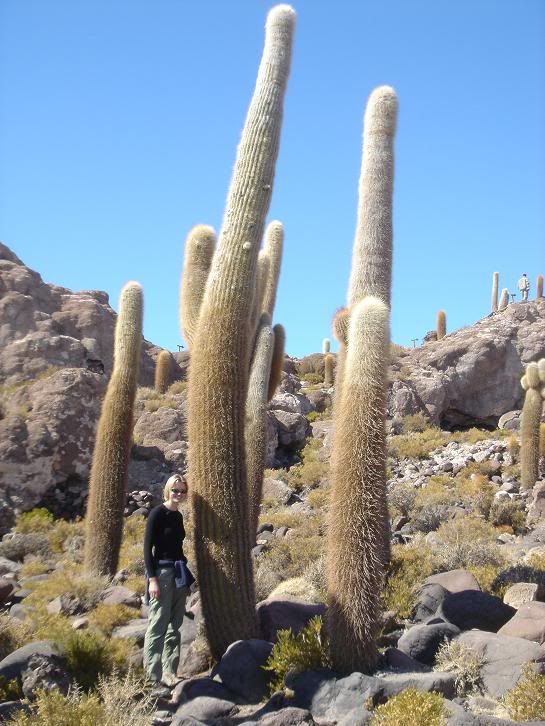
The cacti are well adapted to their environment, coated with abundant hairs that protects them from the intense sunlight which is reflected from all directions from the bright white salt. The hairs probably also help the cacti to cope with the abrupt temperatures, which can range from -25 to 25 Degrees Celcius. They certainly recieve little rain, about 400mm a year. The atmosphere is incredibly dry too, the humidity reader at the information office on the island read 50%.
After lunch we drove on leaving the Salar and onto the Dry Puna of the Atliplano. The vegetation in the dry puna is characteristically tropical alpine herbs with a few dwarf shrubs. This region recieves less than 400mm of rainfall a year anbd with a very long 8 month dry season. You certainly had be tough to grow here!
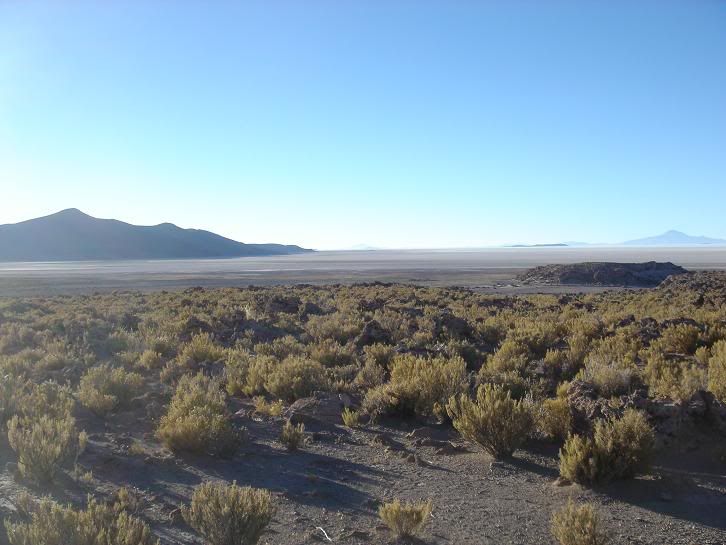
Tough plants of the Altiplano
However, there is a long tradition of ancient cultures who made a living off the land. Quinoa Chenopodium quinoa has been cultivated in the altiplano 1000s of years. It was one of the most sacred foods of the ancient Incas, who called it Chesiya mama or mother grain. An annual herb both the leaves, which are rich in vitamin A and the seeds (after the bitter saponin coat has been removed) are edible. The seeds are highly nutrious, being rich in protien, high in fibre and partiucarly rich in Lycine- an amino acid and is also a good source of calcium, phosphorous and vitamins B and E.
The altiplano has areas of grassy stepes which mainly contain grass species of Calamogrostis, Festuca and Stipa.
The areas richness in minerals is aparent in the lakes. Laguna Verde's green colour is a result of the high concentrations of Lead, sulphur and calcium carbonate. Larguna Colorada is a rusty red colour from the algae that feed that thrive on the mineral rich water and its shoreline is white from deposits of sodium, magnesium, borax and gypsum.
In rocky areas of the altiplano I came across the biggest cushion plants I'd ever seen! Locally called Llareta or Arozella compacta which is found growing in between rocks. It forms very dense cushions and is a member of the APIACE or carrot family - it didn't look anything like a carrot to me! It only grows 2mm per year. I noticed when I touched the plant it had a sticky resin, this has a high calorific value and is why local people have used the plant as a source of fuel for fire, as there is a shortage of trees for firewood in the area. In the past the plant has been over exploited as a fuel in the industry for Salpetre and copper and populations are at risk.

Huge Arozella!
A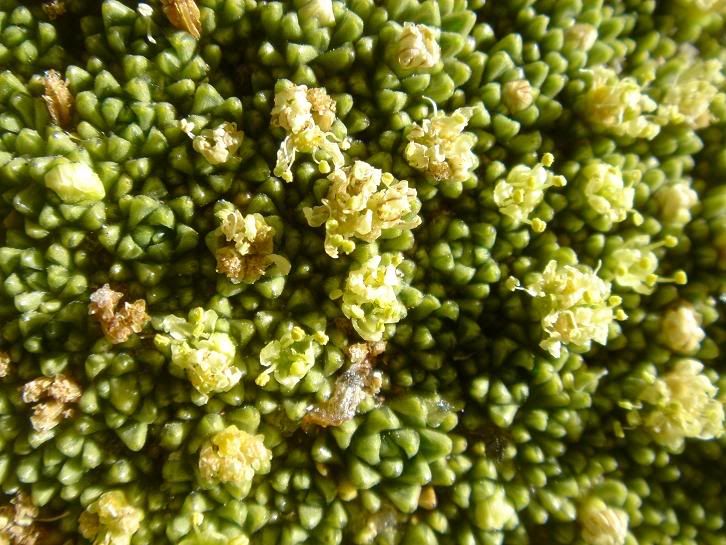 rozella up close
rozella up close
During our drive through the volcanous region I also came across another species of Cacti, Cumulopuntia ignescens. And lots of small shruby plants with coniferous like scales on them, again another adaptation to cope with the extreme dryness of the environment.
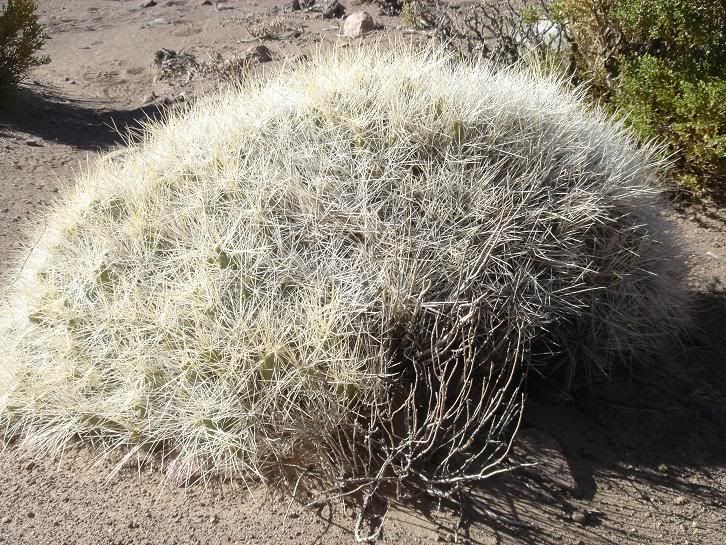
Cumulopuntia ignescens
The main threats to the vegetation growing on the Andean puna is from grazing, Camalids (Llamas and Alpacas), goats and sheep degrade the vegetation so much that it makes it difficult for plants to complete their life cycles. firewood collection and clearance for cultivation also has a significant impact.
Referrences:
www.worldwildlife.org/wildworldprofiles/terrestrial/nt/nt1001_full.html
www.uta.cl/flora_nativa/lista_del_parque.html

0 Comments:
Post a Comment
<< Home